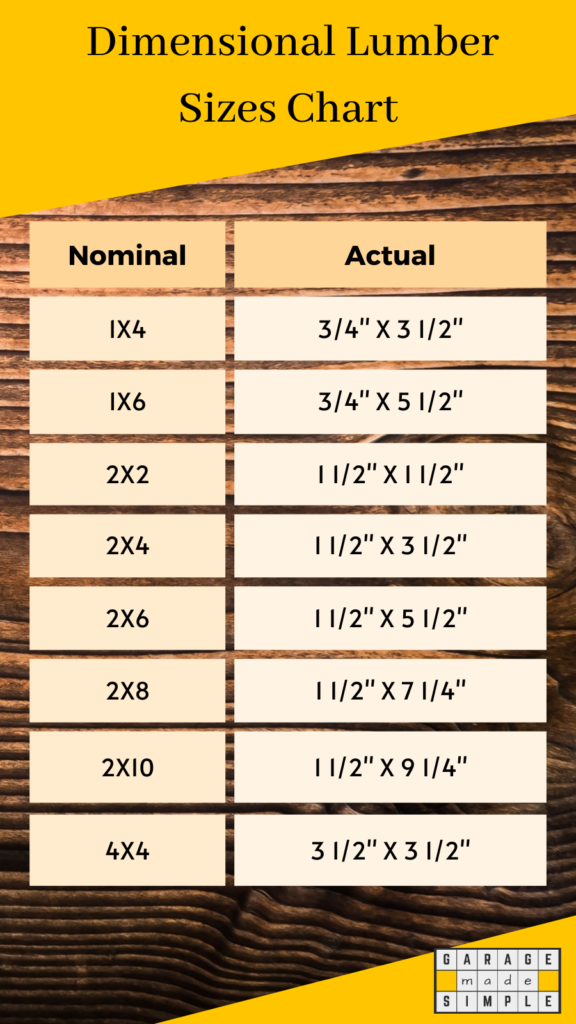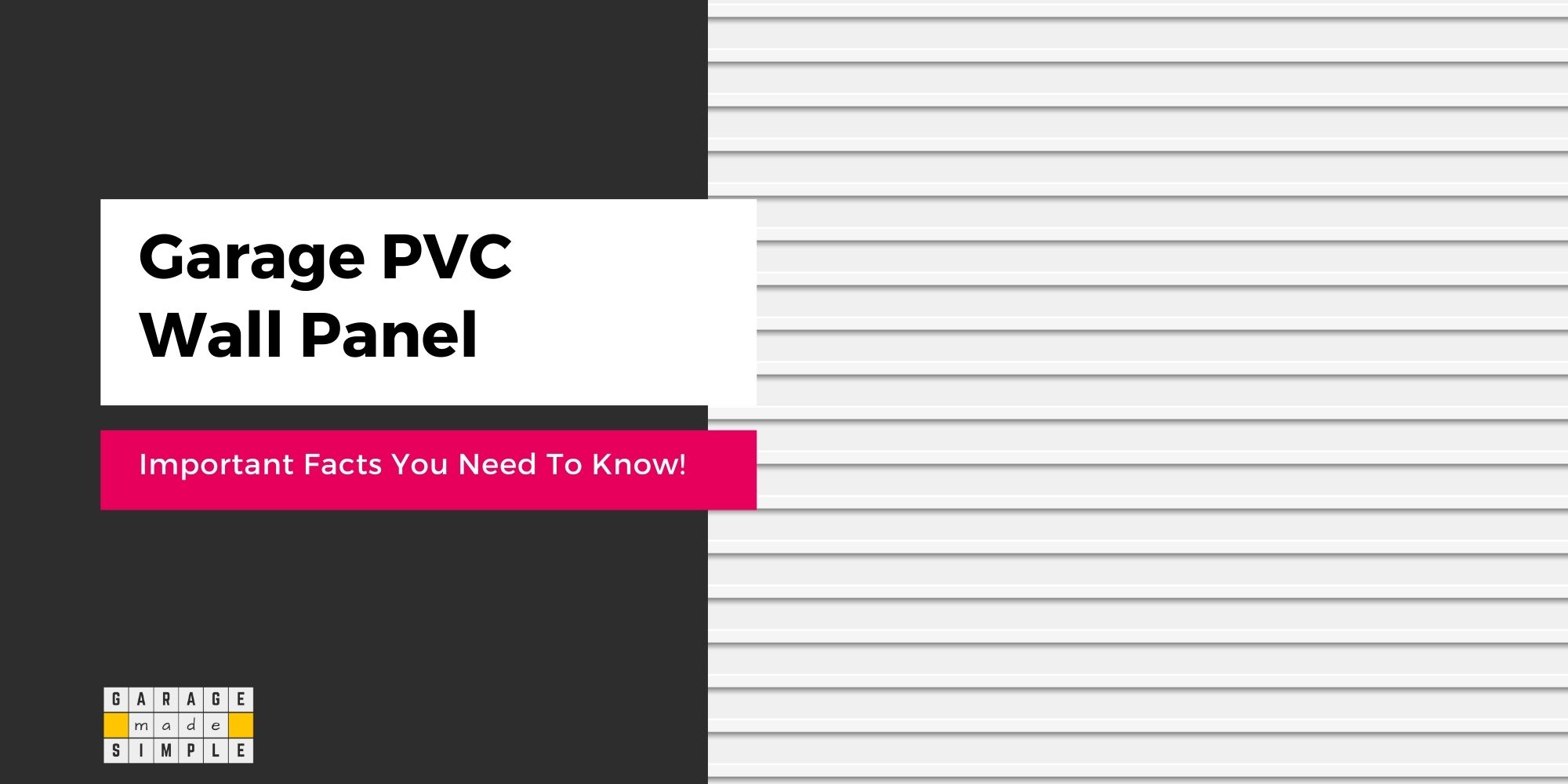Dimensional Lumber Sizes Chart: 3 Super Helpful Options Now!
garagemadesimple.com is a participant in the Amazon Services LLC Associates Program, an affiliate advertising program designed to provide a means for sites to earn advertising fees by advertising and linking to Amazon.com . The website is also an affiliate of a few other brands.
What Sizes Does Dimensional Lumber Come In?
The Nominal Size of dimensional lumber is not the same as its Actual Size. You need to use a “Dimensional Lumber Sizes Chart” to get the answer. Here I give you 3 super helpful methods of getting the information on the most common and popular sizes.
1. Drop Down Menu for Conversion
To get the “actual size” please select the “nominal size” from the drop down menu in the first column.
| Nominal Size | Actual Size |
|---|---|
2. Dimensional Lumber Sizes Chart
| Nominal Size | Actual Size | Common Uses |
|---|---|---|
| 1×4 | 3/4″ x 3 1/2″ | Trim, Door Jambs, Shelves, etc. |
| 1×6 | 3/4″ x 5 1/2″ | Siding, Decking, Paneling, etc. |
| 2×2 | 1 1/2″ x 1 1/2″ | Furniture, Fencing, Sheds, etc. |
| 2×4 | 1 1/2″ x 3 1/2″ | Framing, Studs, Joists, Rafters, etc. |
| 2×6 | 1 1/2″ x 5 1/2″ | Framing for More Insulation & Heavier Loading |
| 2×8 | 1 1/2″ x 7 1/4″ | Structural Framing, Floor Joists, Decking |
| 2×10 | 1 1/2″ x 9 1/4″ | Structural Framing, Floor Joists, Decking |
| 4×4 | 3 1/2″ x 3 1/2″ | Posts, Beams, Retaining Walls, etc. |
3. Easy to Save Infographics

What is Dimensional Lumber?
Dimensional lumber is cut and planed on all 4 sides, usually from softwood trees, such as, spruce, pine, fir, etc. Dimensional lumber is extremely popular in the construction industry because it is cut to standard sizes, such as 2×4, 2×6, etc. THe standardization makes the job of the architects, contractors and DIYers really easy.
Dimensional lumber is most commonly used in framing projects, such as building houses and decks. It is also used for flooring, roofing, and other structural applications.
Dimensional lumber also finds uses in the warehousing & transportation industry to make pallets, crates, shelving, etc.
The key advantages of using dimensional lumber in construction is:
- Standardization
- Affordability
- Availability
- Workability
- Sustainability
Why Is There a Difference Between the Nominal & Actual Size of Lumber?
A 2X4 should be 2” X 4”, but it is not. In fact it is 1 ½” X 3 ½”. Why is there a difference between the nominal and actual size of lumber?
Dimensional lumber is sawn and then planed and cut to a specific size. Lumber is cut before it has been dried and planed. But wood shrinks as it dries and loses moisture.
So the final size, after drying, will be somewhat smaller. How much smaller? That depends on a host of factors and can not be controlled or predicted.
The lumber industry decided to make life easier for designers, architects, contractors and DIYers by standardizing the final dimensions. However, they retained the earlier nomenclature. So a 2X4 continued to be called 2X4 but the actual size got standardized to 1 ½” X 3 ½”.
This is why the “actual” size is different and smaller than the “nominal” size.
What Is Dimensional Lumber Used For?
What is 1X4 Commonly Used For?
1X4 is mostly used for trim work.
Smaller sized boards are used for trim work, such as casing, shelf cleats, cabinet door stiles & rails, wall & cabinet panels, pilasters, etc.
Larger sized boards can be used for structural elements, such as stair stringers, door jambs, stair posts, shelves, etc.
What is 1X6 Commonly Used For?
Some common uses of 1×6 lumber include:
- Horizontal Siding: for exterior walls.
- Decking Boards: for outdoor decks.
- Flooring: specially for porches and other outdoor spaces.
- Trim and Molding: around doors & windows.
- Shelving: for closets, bookcases, etc.
- Ceiling & Wall Paneling: for interior spaces.
- Fencing: as a picket or rail for fencing.
What is 2X2 Commonly Used For?
2×2 lumber can be used in several projects around the home where heavy loads are not involved. Some examples are:
- Framing: for small structures such as sheds, gazebos and pergolas.
- Furniture: used as legs, supports, and frames for furniture such as tables, chairs and benches.
- Decking: used as decking balusters, railing posts and stair stringers
- Trim and Molding: around baseboards, windows, doors, etc.
- Shelving:
- Decorative: make picture frames, wall art and other decorative items.
- Fencing: as pickets for fencing.
What is 2X4 Commonly Used For?
The most common uses of 2X4 are:
- Framing: 2x4s are widely used as the primary structural support for houses, garages, sheds, etc.. They are used as studs to frame walls, roof trusses, and floor joists.
- Furniture: 2x4s can be and are sometimes used to make functional furniture, such as tables, chairs, beds, shelves, etc.
- Home Remodeling: 2x4s are great for making partition walls, adding doors or windows or building a new garden shed.
- DIY Projects: 2x4s are a popular choice for DIY projects because they are versatile and easy to work with. You can do so much with it. Make work desks, outdoor seating or raised garden beds.
What is 2X6 Commonly Used For?
A 2X6 is 2” deeper than a 2X4. While 2X6 can be used for any application that a 2X4 can be used, it is better to use 2×6 lumber when the structure needs to support more weight or when more insulation is needed.
The additional depth of a 2×6 provides higher structural strength and longer spans. A 2X6 is, therefore, a better choice for certain applications such as floor joists and rafters.
What are 2X8 and 2X10 Commonly Used For?
2X8 and 2X10 dimensional lumber is generally used for structural framing of interior & exterior walls, floor joists and decking.
What is 4X4 Commonly Used For?
4×4 is typically used for posts, framing, and support beams in decks and other structures. It can also be used for outdoor hardy furniture.
More specifically 4X4 can be used for building:
- Fence & Gate Posts
- Decks & Patio Supports
- Garden Beds and Retaining Walls
- Hardy Outdoor Furniture such as tables, chairs, benches, etc.
Thank you very much for reading the post. I do hope you found it informative and useful.





